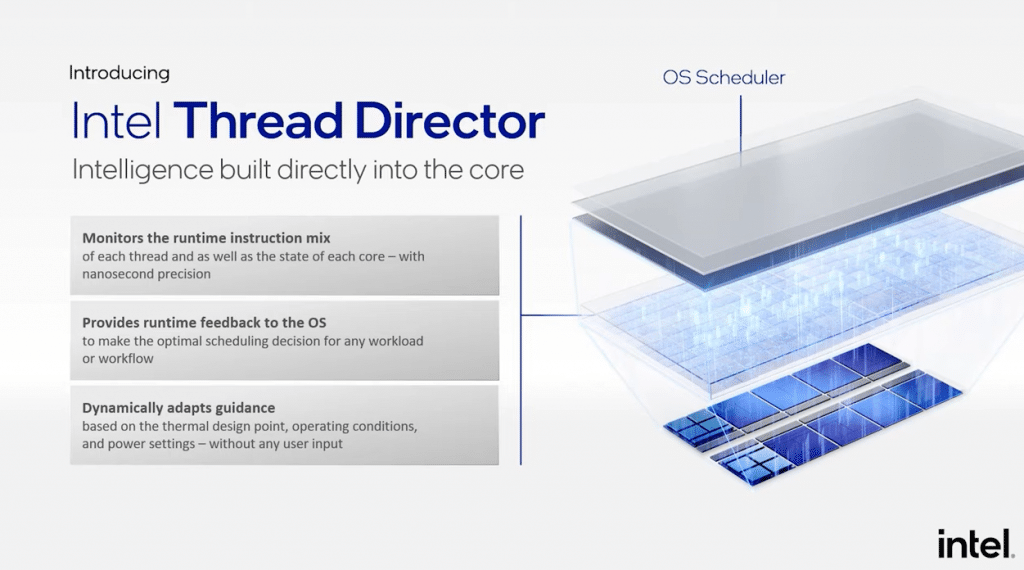Intel’s 12th generation CPUs are hitting the market with their all-new 10nm architecture. The most amazing thing is that these CPUs are competing seriously with the AMD CPUs. This time, Intel not only came up with performance but also amazing price tags. In fact, CPUs like i9 12900K are now on the top rankings when it comes to consumer-level CPU markets.
The most impressive thing about this 12th generation (Alder Lake) CPUs is their two different kinds of CPU cores. P-Cores and E-Cores.
You might have heard about them. P-Core stands for Performance core whereas E-Core stands for Efficiency core. Not all the 12th generation CPUs come with two kinds of cores but only the high-end ones. So, here we are going to discuss the difference between these two kinds of cores that Intel has introduced.
In this article, we are going to discuss this new hybrid design launched by Intel. We will see what is so special about it and how it is going to benefit the end-users. So, let’s get started.

What is the difference between P-Core and E-Core?
You can consider P-Core or Performance Core as the normal cores you see in other CPUs out there. These cores are focused on the raw CPU performance. As the name suggests, a P-Core will handle the more performance-demanding tasks.
E-Core or Efficiency Core is the new addition here. These are actually multiple cores embedded in a single P-Core. So, what these cores basically do is reduce the power consumption while working effectively on multitasking.
The P-Core is basically for outright performance while the E-Core is for efficiency. Intel’s new technology called Intel Thread Director is the main component that ensures that both these cores work together automatically. We will talk about that later but first, let’s know some more about the P-Cores and E-Cores.

What are Performance Cores? (P-Core)
You can say by its name that the P-Core is designed for raw performance. The P-Cores come with the least latency and reach the best limits of single-thread performance. They call the P-Core’s micro-architecture, code-named Golden Cove, the most powerful x86 design of the time. If we look at the last generation’s Cypress Cove (architecture is Rocket Lake), the company claims that the latest Golden Cove has a 19% performance improvement.
The Golden-Cove architecture used in P-Core is much wider, deeper, and smarter. It has more decoders, execution ports, a bigger buffer, and a larger scheduling window as compared to its earlier architecture. Another special thing about the P-Core is they come with an Intelligent Branch prediction system. It is responsible for cutting down the latency.
This system actually includes caches with prefetch engines that are designed to observe the program behavior. It can then predict future memory access patterns. Golden Core or P-Cores have the larger L1 Cache to improve the deeper executions.
What are Efficient Cores? (E-Cores)
The code name for E-Cores is Gracemont. The purpose of E-Cores is simple. These cores are there to handle most of the possible tasks while taking the least amount of space on the die and power. If we talk about the space, 4 E-Cores can fit inside the same space as 1 P-Core.
The E-Cores are built for multitasking and multi-thread performance. They come with a deep front-end and wide backend. Again, the branch predictors are there in E-Cores as well reducing the latency.
If we compare it with the skylake microarchitecture (used until 10th Gen Intel Core), the Alder Lake E-Cores will offer the same energy performance per clock while using a fraction of power.
According to Intel, an Alder Lake E-Core can offer equivalent performance to Skylake at 40% less power. They conversely include that one E-Core can offer 40% more performance than a Skylake core using the same amount of power.
It is important to mention that E-Cores don’t support hyperthreading. The main purpose of introducing E-Cores is just to pack a higher amount of cores inside a smaller space and handle multitasking using a very less amount of power.
Importance of Intel Thread Direction in P-Cores and E-Cores
Thread Director is a dynamic system developed just to make sure the right core and right threads are executed at the right time. In other words, the scheduling is not relying on the conventional approach of static rules. Instead, they have designed the thread direction as a dynamic system that uses real-time feedback.
The main purpose of this technology is to help the OS scheduler always make the right decision when it comes to executing any command.
The OS schedulers do their job by observing the available and limited information like the application status. Thread Director keeps a note on various other things like the status of cores and telemetry.

Let’s understand it with an example:
When you fire up a game, video editing software, or other software that needs performance, the Intel Thread Director will directly go to the P-Core and hand these works to it. Other background tasks such as recorders, email, browsers, etc will be assigned to the E-Cores. Now, if there is another P-Core intensive task coming along the way, this technology will make sure to properly assign some tasks to the E-Cores and make room on the P-Cores.
Thread Director and Windows 11
The Thread Director Technology is supposed to work to its fullest on the latest Windows 11 OS version. However, you can make use of these CPUs on other OS as well. But, Intel and Microsoft and working together to make this system highly effecient and properly optimize the thread director with Windows 11.
So, if you are going for a 12th generation Alder Lake Intel CPU, you will get its best benefits with Windows 11 rather than Windows 10.
These companies are making sure that the parking system of cores is perfect. With this technology, the goal is to not rely upon static instruction for OS scheduling. Instead, make the overall system so flexible that it knows what to do when you need performance and what to do when you need efficiency.
Are 12th Gen Alder Lake CPUs really worth the hype?
The Intel Core i9 12900K is competing directly with the Ryzen 9 5950X. And, it is beating the Ryzen’s beast in not only gaming but also in productivity. The prices of both are almost the same. Yet, Intel is offering amazing performance results. Yes, the multi-core performance in synthetic benchmarks could be good from Ryzen’s top players.
But, if you compare the single-core performance, Intel is now winning the game. The prices are now cheaper and there is no difference in performance. In fact, the 12th generation alder lake CPUs are there to revive Intel’s lost legacy in its domain.
All CPUs in Intel 12th Generation Alder Lake Line Up
Not all the Intel 12th Generation CPUs come with P-Cores and E-Cores. Only Core i9 and i7 will have these different cores. There are some CPUs in 12th generation i3 and i5 but they don’t come with the E-Cores. Only P-Cores are there in them.
| Processor branding | Model | P Cores (Threads) | E Cores (Threads) |
|---|---|---|---|
| Core i9 | 12900KS | 8(16) | 8(8) |
| Core i9 | 12900K | 8(16) | 8(8) |
| Core i9 | 12900KF | 8(16) | 8(8) |
| Core i9 | 12900 | 8(16) | 8(8) |
| Core i9 | 12900F | 8(16) | 8(8) |
| Core i9 | 12900T | 8(16) | 8(8) |
| Core i7 | 12700K | 8(16) | 4(4) |
| Core i7 | 12700KF | 8(16) | 4(4) |
| Core i7 | 12700 | 8(16) | 4(4) |
| Core i7 | 12700F | 8(16) | 4(4) |
| Core i7 | 12700T | 8(16) | 4(4) |
| Core i5 | 12600K | 6(12) | 4(4) |
| Core i5 | 12600KF | 6(12) | 4(4) |
| Core i5 | 12600 | 6(12) | No E-Core |
| Core i5 | 12600T | 6(12) | No E-Core |
| Core i5 | 12500 | 6(12) | No E-Core |
| Core i5 | 12500T | 6(12) | No E-Core |
| Core i5 | 12490F | 6(12) | No E-Core |
| Core i5 | 12400 | 6(12) | No E-Core |
| Core i5 | 12400F | 6(12) | No E-Core |
| Core i5 | 12400T | 6(12) | No E-Core |
| Core i3 | 12300 | 4(8) | No E-Core |
| Core i3 | 12300T | 4(8) | No E-Core |
| Core i3 | 12100 | 4(8) | No E-Core |
| Core i3 | 12100F | 4(8) | No E-Core |
| Core i3 | 12100T | 4(8) | No E-Core |
You can see that only the 12th generation CPUs from the top line-up is coming with the efficiency cores.
Wrap Up
I hope you are now having a good idea of the difference between P-Cores and E-Cores. This is definitely an amazing technology but still has a long way to go when it comes to optimizations. Still, these CPUs are performing great and lots of people are happy about it.
If you have any other queries, you can comment below.

I am Anshul Rana, an experienced author specializing in PC gear reviews and Windows 10 software tutorials. With a strong passion for technology and an in-depth understanding of the PC industry, I provide insightful and detailed analyses of computer peripherals, gaming gear, and software solutions. My writing style is concise yet informative, making complex topics accessible to both beginners and advanced users. Through my reviews and tutorials, I aim to offer valuable guidance, helping readers make informed decisions to enhance their PC experience and explore the vast possibilities of Windows 10 software.









